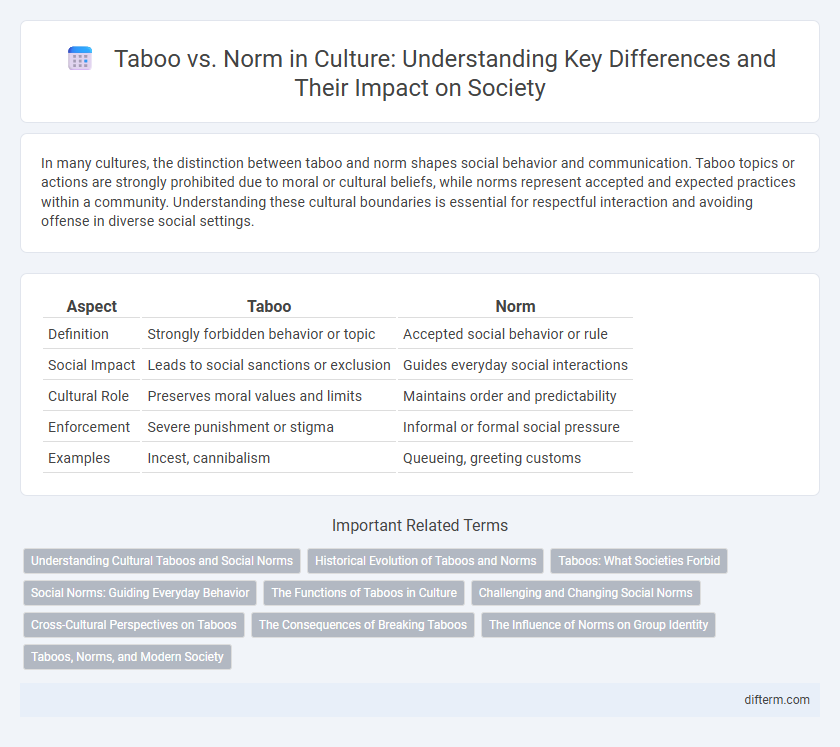In many cultures, the distinction between taboo and norm shapes social behavior and communication. Taboo topics or actions are strongly prohibited due to moral or cultural beliefs, while norms represent accepted and expected practices within a community. Understanding these cultural boundaries is essential for respectful interaction and avoiding offense in diverse social settings.
Table of Comparison
| Aspect | Taboo | Norm |
|---|---|---|
| Definition | Strongly forbidden behavior or topic | Accepted social behavior or rule |
| Social Impact | Leads to social sanctions or exclusion | Guides everyday social interactions |
| Cultural Role | Preserves moral values and limits | Maintains order and predictability |
| Enforcement | Severe punishment or stigma | Informal or formal social pressure |
| Examples | Incest, cannibalism | Queueing, greeting customs |
Understanding Cultural Taboos and Social Norms
Cultural taboos are prohibitions against behaviors or practices considered unacceptable or offensive within a society, often rooted in moral, religious, or traditional values. Social norms represent the accepted behaviors and expectations that guide everyday interactions and maintain social order within cultural groups. Understanding the distinction between taboos and norms reveals how societies regulate conduct, enforce conformity, and negotiate identity boundaries.
Historical Evolution of Taboos and Norms
Taboos and norms have evolved throughout history as mechanisms to regulate social behavior and maintain order within communities. Early societies established taboos often linked to religion or survival, such as restrictions on food and sexual conduct, which gradually transformed into social norms governed by cultural values and collective consensus. The historical evolution from rigid taboos to more flexible norms reflects changing power structures, moral frameworks, and intercultural interactions shaping societal expectations over time.
Taboos: What Societies Forbid
Taboos represent deeply ingrained prohibitions within cultures, dictating behaviors considered unacceptable or offensive, such as incest, cannibalism, and desecration of sacred objects. These prohibitions serve to maintain social order and reinforce collective values by evoking strong emotional responses and social sanctions when violated. The universality of taboos emphasizes their role in protecting group cohesion and cultural identity across diverse societies.
Social Norms: Guiding Everyday Behavior
Social norms are unwritten rules that govern acceptable behavior within a culture, shaping daily interactions and maintaining social order. Unlike taboos, which prohibit actions considered morally or socially unacceptable, social norms provide guidance on polite and expected behavior in various settings. Understanding social norms is crucial for individuals to navigate societal expectations and foster harmonious communities.
The Functions of Taboos in Culture
Taboos function as powerful social regulators by prohibiting behaviors considered harmful or unacceptable, thus preserving group cohesion and moral order. They reinforce cultural identity by delineating boundaries between sacred and profane, shaping collective values and customs. Enforcing taboos helps maintain social stability by preventing conflicts and ensuring adherence to societal expectations.
Challenging and Changing Social Norms
Challenging and changing social norms often begins with questioning deeply ingrained taboos that regulate acceptable behavior within a culture. Acts that defy these taboos can spark social movements and shifts in collective attitudes, leading to new norms that better reflect evolving values. The tension between maintaining tradition and embracing progress drives cultural transformation and redefines societal boundaries.
Cross-Cultural Perspectives on Taboos
Taboos vary significantly across cultures, reflecting deeply ingrained beliefs and social values that dictate what is considered unacceptable or forbidden behavior. Understanding cross-cultural perspectives on taboos reveals how practices regarded as normal in one society can be seen as offensive or prohibited in another, influencing intercultural communication and social interaction. Anthropological studies emphasize that navigating these cultural differences is essential for fostering respect and reducing misunderstandings in globalized settings.
The Consequences of Breaking Taboos
Breaking taboos often results in severe social sanctions, including ostracism, legal penalties, and loss of reputation within the community. These consequences serve to maintain social order by reinforcing cultural values and discouraging behaviors considered morally or ethically unacceptable. Persistent violation of taboos can lead to long-term stigmatization, limiting an individual's opportunities for social integration and acceptance.
The Influence of Norms on Group Identity
Norms profoundly shape group identity by establishing shared expectations and behaviors that bind members together, reinforcing cohesion and social order. These unwritten rules dictate acceptable conduct and foster a collective sense of belonging, influencing group values, traditions, and cultural expressions. Deviations from norms can lead to social sanctions, highlighting their critical role in maintaining group unity and identity.
Taboos, Norms, and Modern Society
Taboos, deeply ingrained prohibitions rooted in cultural beliefs, regulate behaviors considered harmful or offensive, often shaping societal values more rigidly than norms. Norms, as expected behavioral standards, evolve with modernization, yet many taboos persist in influencing social interactions and legal frameworks despite changing contexts. In modern society, the tension between enduring taboos and emerging norms reflects ongoing cultural negotiations around morality, identity, and social cohesion.
Taboo vs Norm Infographic

 difterm.com
difterm.com